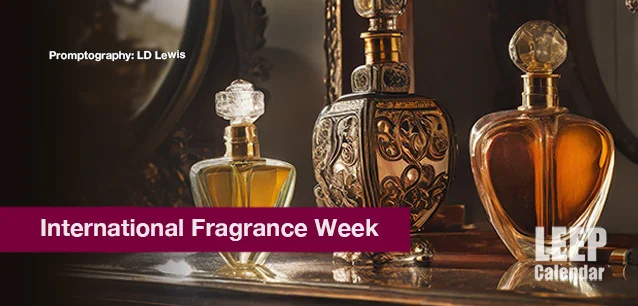 AD
AD
Today is: November 22
Scroll to explore events active on this date.
Additional Events on LEEP
LEEP INK FEATURES

August is Appropos
A toddler playing in the fountain at a park in Santa Fe, New Mexico—Photo LD Lewis. In August, we live through the Dog Days of Summer. It's hot and often humid, and those ...

September is Sassy
Can you hear that sigh of relief from parents worldwide? Yes! September marks the return of students to school, a global phenomenon. Preparations for the ACT and SATs begin earnestly for ...

OOH LA LA, October
October is the busiest month for events, with 5% more happening than in May, the second most eventful month. Sailing enthusiasts will be glued to the finals of this year's Am...
About International Fragrance Week
Retail , Women
Ends: Mar 23, 2025
DESCRIPTION:
International Fragrance Week, organized by The Fragrance Foundation, is a global celebration dedicated to fragrances' art, craft, and history. This week-long event, typically observed in March, brings fragrance enthusiasts, brands, and creators together to honor and explore the diverse world of perfumery.
The Fragrance Foundation, established in 1949, has been instrumental in promoting the fragrance industry. The idea for an International Fragrance Week emerged from the Foundation's efforts to educate the public about scent's artistry and recognize the fragrance industry's cultural and economic importance. The week features various events, including new fragrance launches, promotions, and educational content to deepen the public's understanding and appreciation of fragrance.
MOST POPULAR NOTES IN PERFUMES
When discussing notes in fragrances, these can vary widely depending on cultural preferences, trends, and individual tastes. However, some classic notes have remained consistently popular over time. These include:
Floral Notes: Like rose, jasmine, and lavender, they are often found at the heart of many perfumes and are beloved for their natural, sweet, and romantic qualities.
Citrus Notes: Citrus notes such as lemon, bergamot, and orange are refreshing and uplifting and commonly used in lighter fragrances.
Woody Notes: These notes provide a warm and earthy base to many fragrances, including sandalwood and cedarwood.
Oriental Notes: Spices like vanilla, musk, and cinnamon, known for their rich and exotic scents, fall under this category.
Fragrance use dates back to ancient civilizations, with the earliest recorded use being in Mesopotamia and Egypt. These early fragrances were often made from natural ingredients like flowers, herbs, and spices and were used in religious rituals, as personal scents, and for medicinal purposes.
PERFUME, EAU DE TOILETTE, COLOGNE, AND OUD—WHAT IS THE DIFFERENCE?
Understanding the difference between perfume, cologne, eau de toilette, and oud is crucial in the world of fragrances:
Perfume (Parfum): This has the highest concentration of fragrance oils, typically between 20-30%, making it last the longest on the skin.
Eau de Toilette: Contains a lower concentration of fragrance oils, usually around 5-15%, and is therefore lighter and suitable for everyday wear.
Cologne (Eau de Cologne): Originally a light, citrus-based fragrance from Cologne, Germany, it now refers to fragrances with about 2-4% perfume oils in alcohol and water. It's lighter than eau de toilette and is often used in fragrances marketed to men.
Oud: A specific fragrance ingredient derived from the tropical agar tree, known for its rich and complex scent. It is used in various perfume concentrations and is common in Middle Eastern perfumery.
International Fragrance Week celebrates the sensory experience of fragrances but also highlights their historical and cultural significance. Through this event, The Fragrance Foundation aims to foster a deeper appreciation for the intricate art of perfumery and its impact on our lives.
VIDEOS
SUPPORTING DOCUMENTS
Currently, this event does not have supporting documents.
ADDITIONAL IMAGES
Currently, this event does not have supporting images.
Where would you like to go now?
 AD
AD


/footer-logo.svg)
